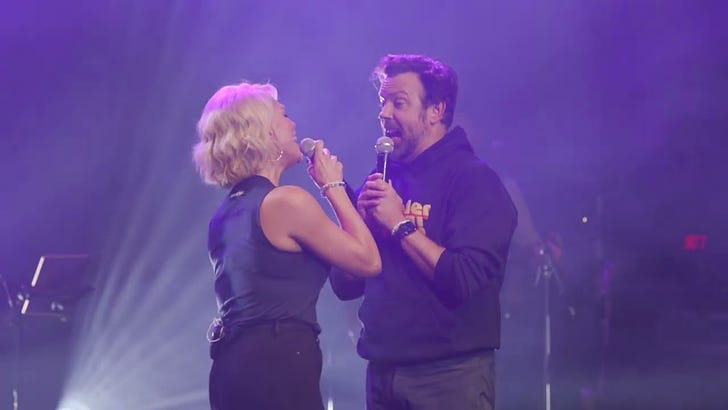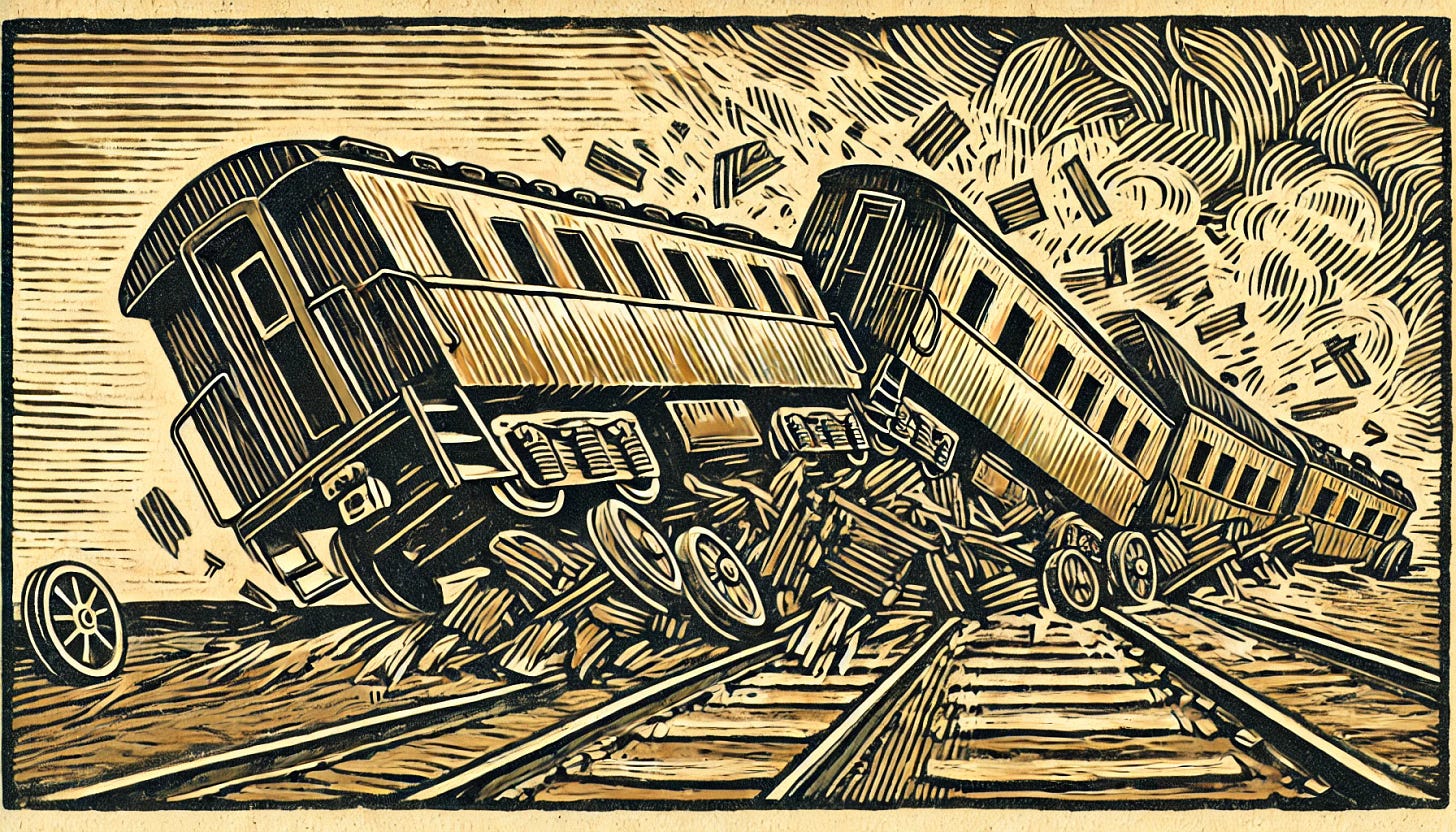Year of the heart
From doctor to patient. A small post-mortem on the election. And Ted Lasso and his boss perform a duet.
PICTURE & WORDS
PLAYING WITH THREES: I’ve had fun combining disparate images into triptychs recently, mostly based on color, texture, and design. I’ve always enjoyed how images can interact to suggest new meanings or new confluences, especially ones that are more intuitive than obvious. On the left is a recent photograph of a geothermal runoff at Yellowstone, juxtaposed to a close-up image of rust from an old shipwreck, and finally a decaying echinacea flower in my sister-in-law’s garden. I like the way the green tail on the left is echoed in the shape and color of the flower petals, whose pink-magentas are also picked up in the rust. What do you see?
PERSONAL HISTORY
My year as a patient
By Barbara Ramsey
A YEAR AGO on Halloween I noticed something was wrong. I went trick or treating with four-year-old Lu and his younger sister Millie on a short, candy-rich route that their mother had staked out. Mom brought along a wagon big enough to hold both of them, knowing they might flag in the face of so much excitement.
Twenty minutes in, both kids opted to ride, so mom and I took turns pulling the wagon. During a short uphill stretch, not even half a block, I was suddenly out of breath. What was happening? I’m a little old lady, but a strong one, and pulling a wagon with two toddlers shouldn’t have left me breathless and out of steam.
It was the first sign that I was having heart trouble and it began a year-long search for a diagnosis and successful treatment. As a physician, my experience with chronic illness over the year has been somewhat different than most patients. My underlying perception of health and disease is highly colored by my medical training and several decades of patient care. That’s mainly been a positive thing.
When the structural abnormalities in my heart were first described to me, I readily understood what I was dealing with. That made it easier to grasp why surgery was needed to fix certain problems and why medications were more suited to others.
More importantly, I have fairly realistic expectations. I don’t have magical associations with health care or awe-filled feelings about 21st century medicine. I internalized certain truisms long ago. Surgeries have complications and medications have side effects. Positives are usually associated with negatives. I’m optimistic but careful not to ratchet my hopes too high. Realism is vital when faced with a health care crisis—expecting super heroes and magic pills only leads to disappointment.
I’m also familiar with “hospital time”. Patients are constantly told what time certain events will occur. “You’ll be getting an EKG at 11 o’clock” or “The chest x-ray will be at 2.” I’m confident these events will happen, but never expect them to occur on schedule. Hospital time is contingent in the extreme—a nurse is called away to another floor, somebody’s heart stopped in room 604, the echo tech is sick. Getting released from the hospital is possibly the most contingent event of all. I never, ever ask when I’ll be discharged and expect to hear a single answer. If some hospital employee naively gives you a specific day and time, don’t count on it.
Being a physician is also handy in evaluating the skills of those who care for me. When I decide a given doctor or nurse is really good, I can make that determination with confidence. I’m not always right, but I don’t second guess them or fret that maybe I should be getting care elsewhere. Once I’ve had enough time and data with which to judge a provider, I generally stick to my assessment. This is huge. Having confidence in those who care for you is an enormous advantage, especially when things don’t go quite as you’d hoped. It’s hard enough to cope with illness itself without worrying about the quality of care you’re receiving.
But of course being a doctor has a problematic side as well. I can be extremely judgmental if medical professionals act badly. I hold them to high standards. When one doctor completely dropped the ball late last year, I was furious—coldly furious. I found another physician ASAP and never went back.
Even with these advantages, I was slow to fully realize that I’d have to prepare for the long haul. It’s been over a year now. Setbacks abounded, complications occurred, and meds failed to have the desired effects. While I’d expected all this in a vague way, I discovered I wasn’t nearly as resilient as I’d hoped.
I expected to improve, but often just stayed sick in new and different ways. I got better but I didn’t get well. This altered my self-image. I’m not as tough as I’d thought. I’ve had to acknowledge that my “realistic” outlook is sometimes misguided. I’ve told friends I’m well, only to be embarrassed to report the following week that no, I’m not so good after all.
That’s been so frustrating. I’d expected to improve at a fairly steady pace, even if not a quick one. Instead, I’ve had a start-and-stop/up-and-down/better-and-worse pace. At times it felt as if I were going in circles instead of forward. Adapting to this reality has been hard and I still haven’t fully accepted it. I know in my head that I may never return to the function I had two years ago, but in my heart I’m like my little friend Lu, now five years old, who regularly says, “Are we there yet?”
TELEVISION
Diversion therapy
WE SPENT MOST of our summer trip to Norway in bed with Covid. I semi-recovered first and then largely stayed with Barbara in the hotel room as she tried to get well. Given her heart condition, I was worried, and at one point we did go the ER in Oslo to reassure ourselves that she hadn’t contracted pneumonia. Fortunately, she had not, and the bill for the visit totaled $72. Chalk one up for nationalized health care.
I did need something to pass the hours as I watched her sleep and listened to her wheeze. That something turned out to be putting on my earphones and re-watching the entire four seasons of Ted Lasso. I know some of you aren’t fans and it took me a long time to respond to the many recommendations from friends to watch it. I generally avoid movies and series about sports. But it turns out that the series is only nominally about football. Mostly, it’s about kindness. In fact, this might be the perfect time to watch if you’re looking for an uplifting diversion from election-related news.
Recently, I came across the video above of Jason Sudeikis, who plays Ted, and Hannah Waddingham, who plays team owner Rebecca, performing a duet at a benefit in Kansas City for amputees. The performance brought all the wonderfulness of the show back to me. They perform the Lady Gaga song “Shallow” from the movie A Star is Born, another tear-jerker favorite.
POLITICS
What happened?
I PROMISED a short guide to some of the better analyses of the national election, but just in the last week, there have been so many beyond my poor power to add or detract. The substack Liberal Patriot (a fair description of my political leanings), has an early guide to interpreting Harris’s loss that covers the basics well. Ruy Tuxiera, a founder and regular contributor to Liberal Patriot, wrote a book with my friend, John Judis, entitled Where Have All the Democrats Gone?, that I’ve previously recommended. I also recommend reading a survey by American Compass that suggests why the so-called “diploma divide” is potent on core values, such as the meaning of the American Dream.
Thirty years ago, I commissioned two pieces for Mother Jones that I’m pleased to say did a good job of predicting liberals’ current predicament. In “Restoring Public Trust,” Daniel Yankelovich wrote, in the wake of the Gingrich takeover of Congress in 1994, that the new GOP would likely over-reach and fail to consolidate a new political realignment. He then suggested a program that could be written today for liberals to regain moral authority. Tuxiera and Judis echoed this theme in a recent op-ed in the New York Times, arguing that Trump’s coalition is unstable and unlikely to cohere if he over-reaches on unpopular stands. The appointments thus far suggest he will. Most people do not want RFK in charge of vaccines.
In 1997 in “The End of the Rainbow,” Michael Lind argued that liberal reliance on a grand coalition of people of color would unravel, as it noticeably did in the past few elections. He presciently wrote:
The strategy of rainbow liberalism has rested on two assumptions. The first is that conservatism would not appeal to nonwhite Americans. The second is that the very policies that promote the rainbow strategy — affirmative action and high immigration — would not produce tensions among the multiracial rainbow’s constituent bands. If these assumptions are wrong, then rainbow liberalism is digging its own grave.
They are, and it is.
Tuxiera had been warning for months that the Democratic Party was bleeding Black and (especially) Latino voters. A 2022 Atlantic article brought that home to me through interviews with Democratic Latino activists in the Arizona and Texas—places that Trump subsequently won. How to regain these voters? I’ll give Judis the last word:
Democrats need to focus on what many of the voters who deserted them want: a growing economy that provides decent job; safe streets; and a safety net that removes Americans’ anxiety about access to healthcare, childcare, and a good education for their children. But voters will ignore even these earnest efforts if Democrats don’t sever their identification with cultural radicalism.









Barbara, your courage and determination are matched by your intelligence and humor - you make me smile. Working with you has made me a better trainer (and wordsmith) However I do question your allegiance to the nut seller.
Hannah Waddington rocks!
Barbara, your story of expectations and reality is a cautionary tale for us all. Your navigation of this journey contains life lessons. Thank you for sharing your perspectives.